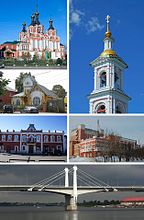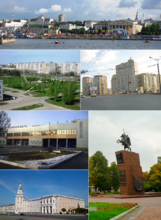&groups=Maske,Track,Aktivitaet,Anderes,Anreise,Ausgehen,Aussicht,Besiedelt,Fehler,Gebiet,Kaufen,Kueche,Sehenswert,Unterkunft,aquamarinblau,cosmos,gold,hellgruen,orange,pflaumenblau,rot,silber,violett)
The Volga is the longest and most water-rich river in Europe with a length of 3530 km. It flows through the European part Of Russia and flows into Caspian Sea.
background

In summer, ships transport goods and tourists on the Volga. Up and down the river, locals and foreigners follow the country's most famous tourist routes. The trips usually only cover a section of the river, for a few days, with short stays in different cities. The beauty of the river, with the most diverse cities, with many historical buildings, make up the charm of such a trip. Cruises are popular with tourists today.
In winter, from around November to April, the Volga freezes. The ice cover can be up to a meter thick. The river is open for cars and even trucks to drive on during this time.
The Volga is part of a network of waterways, and it is connected to the river via canals Baltic Sea, the White Sea, the Black Sea and about the Bosphorus with the Mediterranean Sea connected. The capital too Moscow can be reached on the water.
The course of the Volga is determined by eight barrages and dams that were built for power plants after the Second World War. Huge areas of fertile land and thousands of villages and towns were flooded for this. Today the river often appears like a series of large lakes and less like a stream.
River course
Upper course
- 1 Volga source lies at 228 m in the Valdai heights near the village of Volgowerchowje (Волговерховье)
- 1 Rzhev (Ржев) - to Park of Peace include the German war cemetery Rshew and the war cemetery for fallen Soviet soldiers of World War II.
- 2 Tver (Тверь) - is one of the oldest Russian cities, founded in the 12th century as a trading and craft settlement.
- 2 Ivankovo Reservoir (Иваньковское водохранилище) - this is where the Moscow Canal (Канал имени Москвы), which connects the Volga and the Moskva, begins. You can do it through him Moscow reach by ship.
- 3 Dubna (Дубна́) - Near the city is the northern starting point of the Moscow Canal.

Tver

Lock to the Moscow Canal

Dubna
- 4 Kimry (Кимры) - is located on the left and right banks of the Uglich reservoir
- 5 Kalyasin (Калязин) - large parts of the old town have sunk in the Uglich reservoir.
- 6 Uglich (У́глич) - The dam of the reservoir is located in the middle of the city. Ships overcome the height difference of 11 m between the Rybinsk and Uglitsch reservoirs through a lock canal with a one-chamber lock.
- 7 Myshkin (Мышкин) - the city has 5 museums for about 5,000 inhabitants
- 3 Rybinsk Reservoir (Рыбинское водохранилище) - is the second largest reservoir in Europe. The Volga-Baltic Sea Canal flows into it. For the reservoir, the area was flooded by two cities and around 700 villages.

Kimry

The bell tower of the Nikolaikirche protrudes from the Uglich reservoir.
Middle course
- 8 Rybinsk (Ры́бинск) - The Mologa Museum is dedicated to the history of the origins of the Rybinsk Reservoir.
- 9 Tutayev (Тутаев) - lies on both sides of the Volga and is known for its cathedrals
- 10 Yaroslavl (Яросла́вль) - was founded around 1000 years ago. It goes back to Prince Yaroslav the Wise
- 11 Kostroma (Кострома́) - is one of the oldest and architecturally most attractive Russian cities. It is on the tourist route Golden ring.
- 12 Pljos (Плёс)) - a climatic health resort and a popular tourist destination with well-maintained wooden houses.
- 13 Kineshma (Кинешма)) -
Rybinsk

Yaroslavl

Kostroma

Pljos
- 4 Gorkier Reservoir (Горьковское водохранилище) -
- 14 Nizhny Novgorod (Нижний Новгород) - with 1.25 million inhabitants, it is the fifth largest city in Russia, with a magnificent historic old town.
- 15 Cheboksary (Чебокса́ры) -
- 5 Cheboksarsk reservoir (Чебоксарское водохранилище) -
.png/157px-Nizhny_Novgorod_Montage_(2016).png)
Nizhny Novgorod

Cheboksary
- 16 Novocheboksarsk (Новочебокса́рск) -
- 17 Kazan (Каза́нь) - is a center of Russian Islam, where the architecture of the Orient and Occident unites.
- 6 Kuibyshev reservoir (Куйбышевское водохранилище) - with a length of around 550 km and around 6,450 km², it is the largest reservoir in Europe and the third largest in the world.
- 18 Ulyanovsk (Улья́новск) - there is a bridge over the Volga and Ulyanovsk-Vostochny International Airport
- 19 Tolyatti (Тольятти) - is best known for the Lada factories
- 20 Samara (Сама́ра) - with museums, numerous theaters, a philharmonic orchestra and an opera, also known is the Volga promenade and the so-called Stalin bunker.
- 21 Syzran (Сы́зрань) - is an industrial center and an important railway junction

Kazan

Samara
Lower course
- 7 Saratov reservoir (Саратовское водохранилище) -
- 22 Balakovo (Балако́во) - runs for the Speedway World Championship are held in the Speedway Stadium.
- 23 Saratov (Саратов) - in the picturesque old town there are numerous splendid ensembles of buildings from different centuries, an ethnological museum and a Radishchev art museum can also be visited
- 8 Volgograd reservoir (Волгоградское водохранилище) -
- 24 Kamyshin (Камы́шин) -
- 25 Wolschski (Во́лжский) - an important industrial center. Here the branches Akhtuba, by far the longest of all arms of the Volga estuary.
- 26 Volgograd (Волгоград) - transport hub, administrative and economic center on the Lower Volga. Memorial of the Battle of Stalingrad, the Mother Home Statue is one of the tallest statues in the world at 85 meters.
- The 101 km long 1 Volga-Don Canal (Волго-Донской канал) connects the Volga with the Don and enables shipping between the Caspian Sea and the Sea of Azov and further into that Black sea.
- 27 Astrakhan (Астрахань) - at the beginning of the main area of the Volga Delta. In the city you can find historical buildings from different epochs. The Astrakhan Kremlin, the English Court, the merchants' houses, the numerous churches and the picture gallery are well known. In addition to the local history and World War II, there is also the Khlebnikov Museum.
- 28 Lagan (Лагань) - there are modern Buddhist statues and structures, such as the Red Gate and the Temple Churul. and a local museum.

Saratov

Volgograd
activities
- Bird watching in the delta
Cruises
.jpg/220px-Г.Углич,_Ярославской_обл.,_Россия._-_panoramio_(8).jpg)
Popular starting points for cruises on the Volga are the cities of St. Petersburg and Moscow. Of Moscow across the Moscow-Volga Canal, from St. Petersburg Via Neva, Lake Ladoga, Swir, Lake Onega, Volga-Baltic Canal, White Lake, Sheksna to the Rybinsk Reservoir.
The cruise from Moscow to the Caspian Sea takes about 2 weeks. The international airport in Astrakhan is mostly used for arrival or departure.
See also
literature
- : Guide to river cruises Russia. Trescher Verlag, 2018 (3rd edition), ISBN 9783897943971 , P. 408. All sights along the Volga, Don, Enisej, Lena and Amur
- : A trip along the Volga - traveling by cruise ship. Stürtz publishing house, Oct 2019, ISBN 978-3800348824 , P. 192. A high-quality photo book with over 225 images in large square format
- : Crossing the Neva and Volga: 2 metropolises and 1,771 kilometers of river in 11 days. Books on Demand, 2018, ISBN 978-3748131861 . Travel report











.png/157px-Nizhny_Novgorod_Montage_(2016).png)




